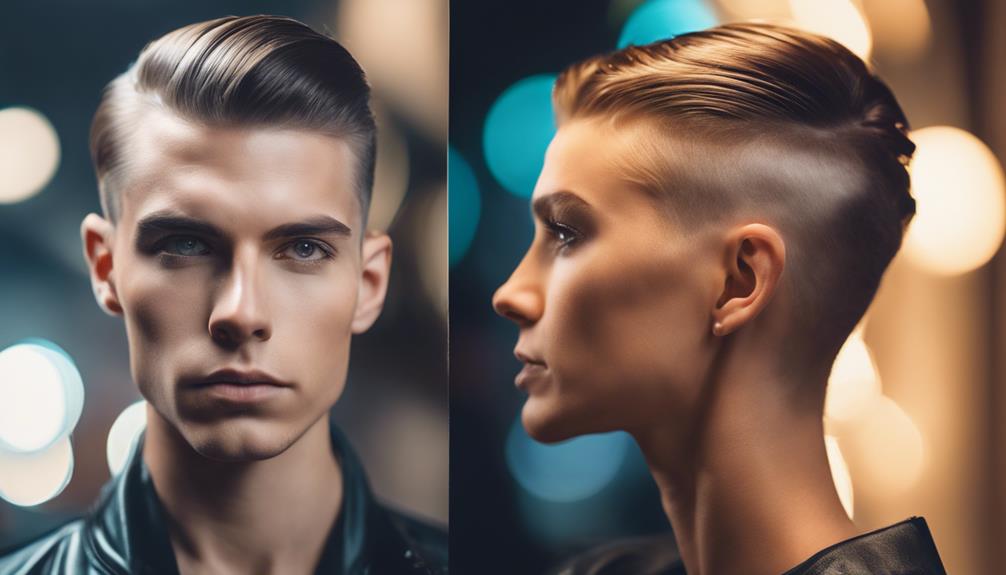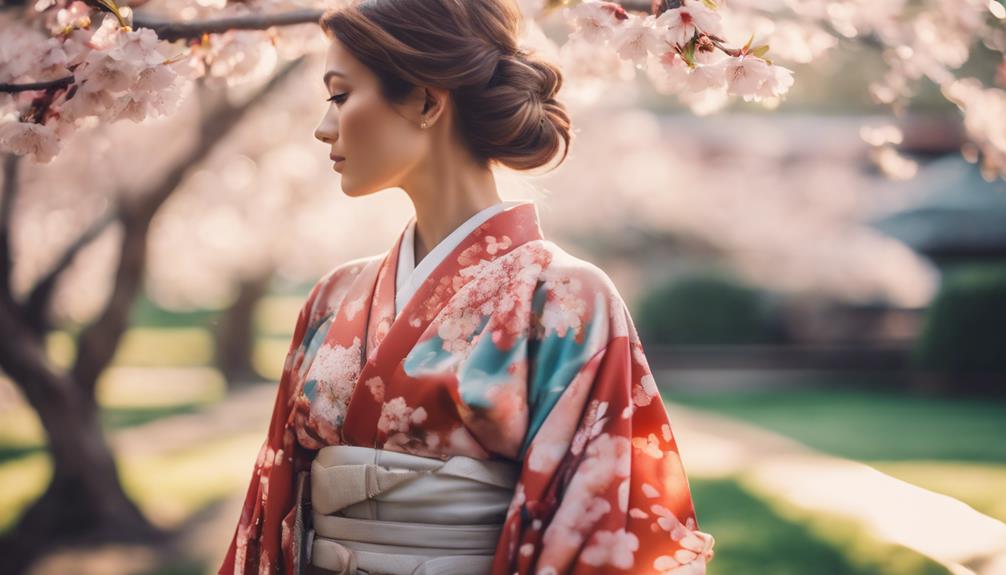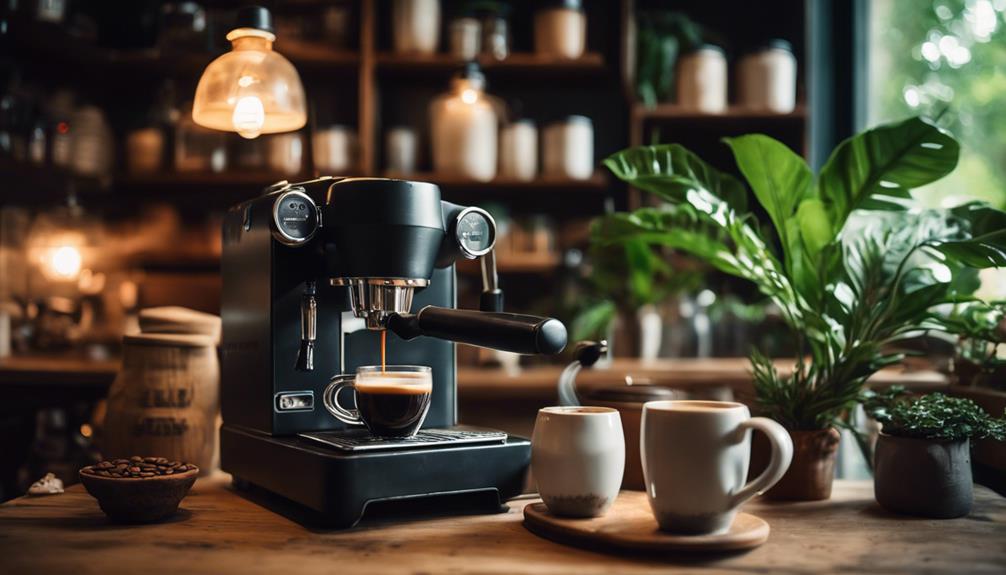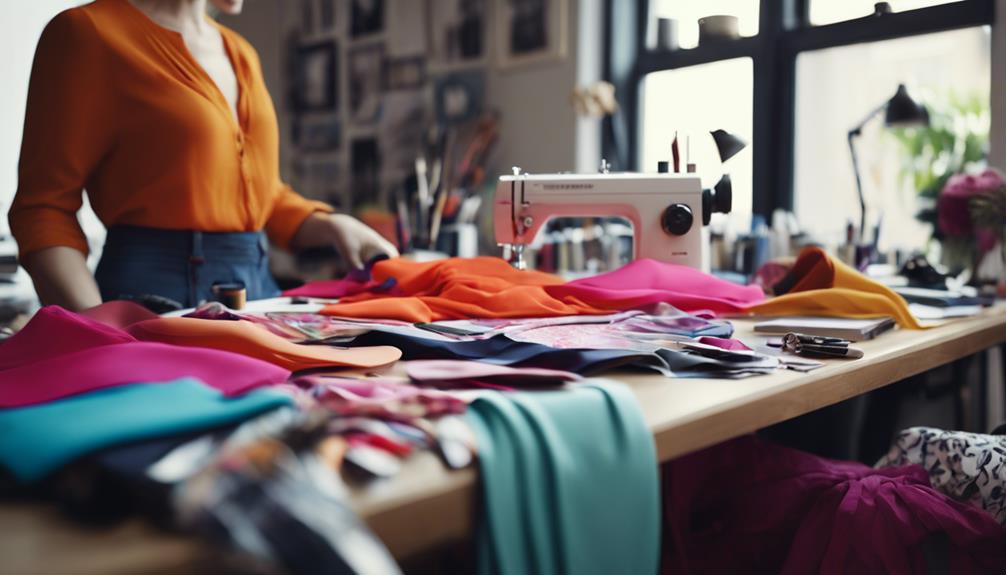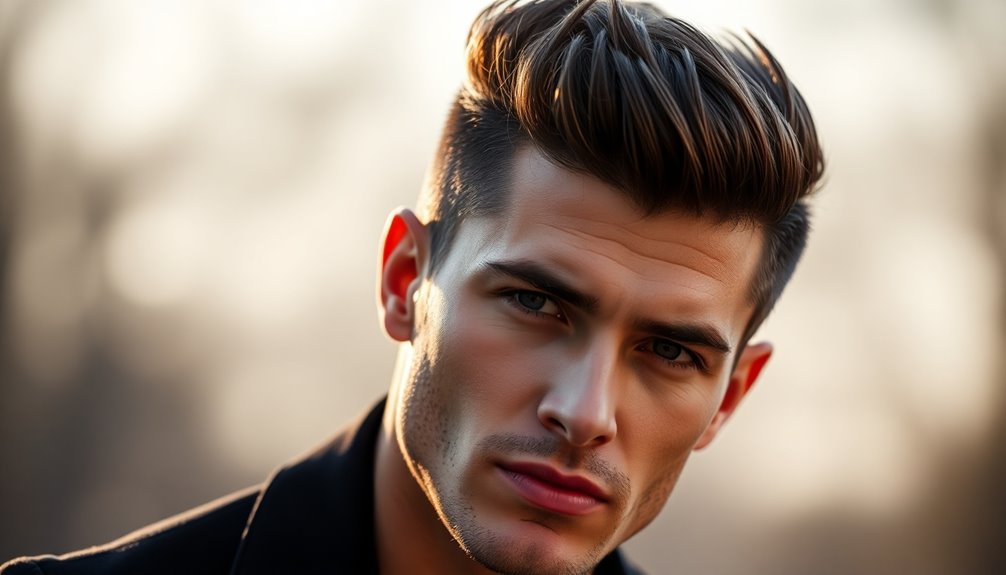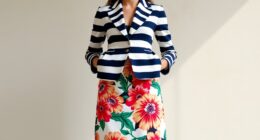When you embrace Spanish dresses, you're celebrating a timeless elegance rooted in centuries of cultural richness. These garments feature intricate lace, vibrant fabrics, and the dramatic ruffles of flamenco styles, perfect for showcasing your personality. Modern designers blend traditional artistry with sustainable practices, ensuring both beauty and eco-consciousness. To elevate your look, consider pairing your dress with statement accessories and classic mantones. Whether you're drawn to the craftsmanship of Balenciaga or the vibrant spirit of flamenco, Spanish dresses offer a unique blend of history and modern flair. There's so much more to discover about these stunning styles.
Key Takeaways
- Spanish dresses embody a rich cultural heritage, blending influences from Roman, Moorish, and Visigothic eras into timeless styles.
- Intricate lace, vibrant fabrics, and personalized embroidery highlight the artistry and craftsmanship of traditional Spanish garments.
- Flamenco dresses, known for their dramatic ruffles and flared skirts, symbolize elegance and are designed for expressive movement.
- Modern Spanish fashion emphasizes sustainability, utilizing organic materials and promoting slow fashion practices for timeless elegance.
- Renowned designers and fashion houses, like Balenciaga and Loewe, merge tradition with contemporary innovation, influencing global fashion trends.
Origin and historical background of the fashion trend/style
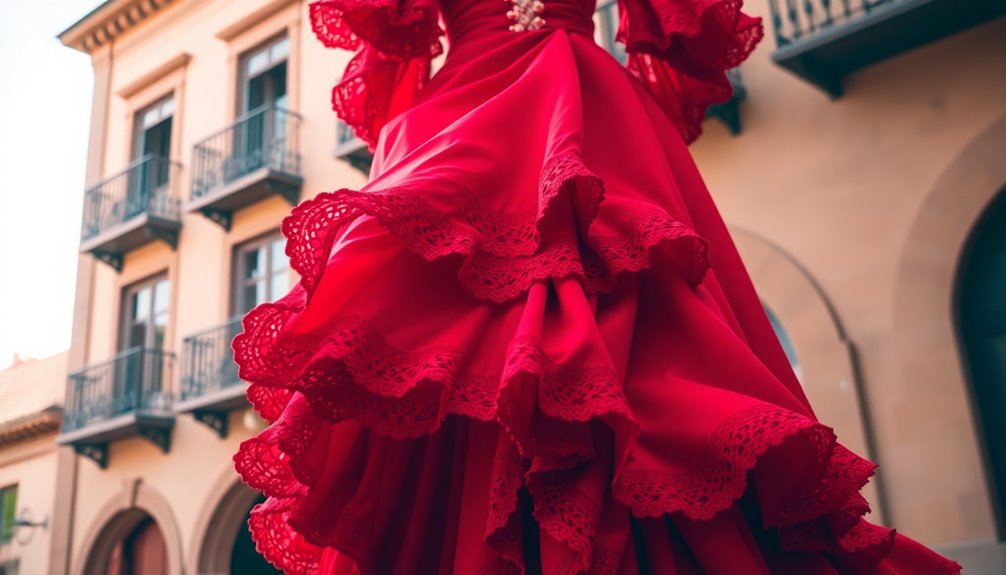
You'll find that Spanish dresses have transformed over centuries, influenced by the rich tapestry of cultures that have graced the Iberian Peninsula.
Royal patronage played a significant role in elevating these styles, making them symbols of elegance and status.
As you explore their origins, you'll see how these historical influences continue to shape modern fashion.
Fashion's Transformation Through Centuries
Throughout history, Spanish fashion has undergone remarkable transformations, shaped by a blend of diverse cultural influences. From the Roman and Visigothic eras to the Moorish impact, each epoch has left its mark, creating a rich tapestry of styles. The traditional flamenco dress, with its vibrant colors and intricate lace, perfectly showcases the artistic spirit and cultural heritage of the country.
In the 18th century, fashion became a display of wealth, with elaborate garments adorned with precious materials and lace, vividly captured in the portraits of affluent women. The introduction of silk and lace from Asia in the 16th and 17th centuries further enhanced the luxuriousness associated with Spanish clothing.
Today, modern Spanish fashion continues to evolve, drawing from these historical influences while embracing contemporary trends. Renowned designers like Balenciaga and Manolo Blahnik exemplify this modern merge of tradition and innovation, creating pieces that honor the past while appealing to today's fashion-forward sensibilities.
As you explore Spanish fashion, you'll find that it's not just about clothing; it's a celebration of the rich history and vibrant culture that define Spain.
Historical Royal Patronage
Royal patronage in Spain has long been a driving force behind the evolution of fashion, especially during the reigns of the Habsburgs and Bourbons. This historical royal patronage significantly shaped fashion trends, promoting opulent fabrics and intricate designs that reflected the wealth and power of the nobility.
The Spanish court emerged as a fashion innovation hub in the 16th and 17th centuries, with royal figures like Queen Isabel of Portugal and Empress Maria Anna setting styles that emphasized grandeur and sophistication.
During the Baroque period, fashion in Spain featured elaborate gowns adorned with lace, embroidery, and rich textiles, showcasing the era's artistic talent and craftsmanship. The influence of Spanish fashion didn't stop at its borders; it extended throughout Europe, affecting styles in other courts, particularly through the export of luxurious textiles and garments to countries like France and Italy.
Today, the historical significance of royal patronage is evident in the enduring popularity of traditional Spanish garments, which continue to inspire modern designers. These timeless pieces reflect Spain's rich cultural heritage, reminding us of the profound impact of royal influence on fashion history.
Key Characteristics
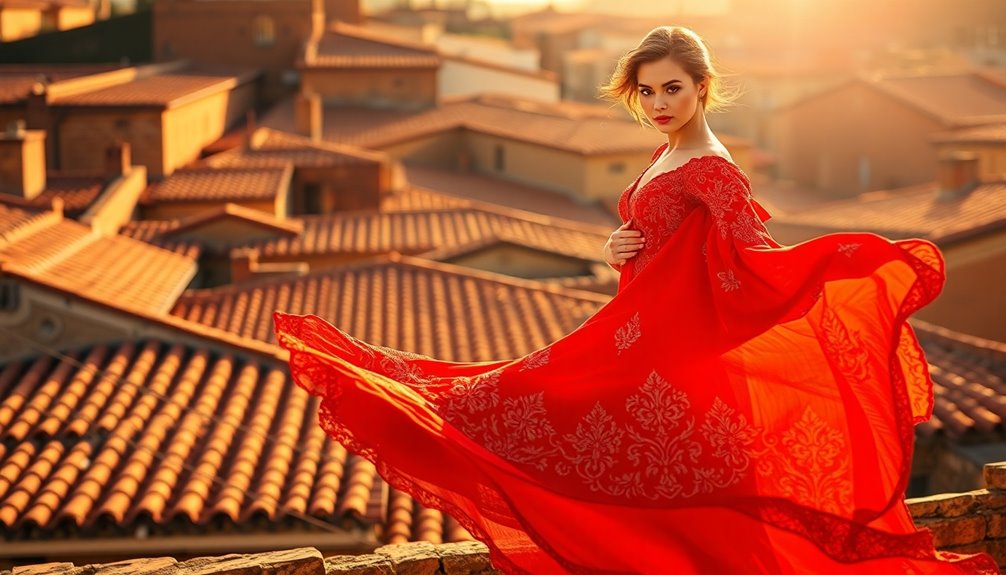
When you think of Spanish dresses, intricate lace and stunning embroidery instantly come to mind.
You'll notice vibrant flamenco-inspired fabrics that capture the spirit of dance, alongside traditional shawls that add elegance and depth to any outfit.
These key characteristics come together to create a look that's both timeless and captivating.
Intricate Lace and Embroidery
Intricate lace and embroidery are defining features of Spanish dresses, showcasing the artistry and craftsmanship that go into each garment. You'll often find intricate lace detailing, a hallmark of traditional craftsmanship, that highlights the skill of artisans in creating delicate designs. This lace isn't just decorative; it embodies the elegance and cultural identity of Spain.
Embroidery plays a significant role, too. You can expect to see floral and geometric patterns, often hand-stitched with vibrant threads that add depth and texture to the garments. The use of contrasting colors, like bright reds and deep blues, reflects Spain's rich cultural heritage and its historical ties to various regions.
Lace mantillas, commonly worn with traditional dresses, are crafted from fine materials like silk, showcasing elaborate patterns that enhance the overall look.
Spanish dresses also embrace elements of flamenco style, featuring ruffles and tiered designs. These are beautifully accentuated by embroidered details and intricate lace trims, adding to the visual appeal. Together, these elements create garments that capture the essence of Spain's timeless elegance.
Vibrant Flamenco-Inspired Fabrics
Spanish dresses not only shine with intricate lace and embroidery but also come alive with vibrant flamenco-inspired fabrics. These fabrics are characterized by bold colors like red, black, and white, capturing the lively spirit of flamenco performance and Spanish culture.
You'll notice intricate patterns, including polka dots and floral designs, which are essential elements of traditional flamenco attire.
When selecting a flamenco dress, lightweight and flowing materials are crucial. Fabrics such as silk, satin, and cotton allow for dramatic movements and twirls, enhancing your performance.
The ruffles and frills that adorn these dresses add texture and volume, making every spin and step visually captivating.
Whether you're dancing at a fiesta or simply embracing the elegance of Spanish fashion, these flamenco-inspired fabrics embody both comfort and style.
The combination of vibrant hues and intricate designs ensures that you'll stand out, embodying the essence of flamenco with every move.
Traditional Spanish Shawls
While exploring the world of traditional Spanish fashion, you'll quickly discover the elegance of mantones, or traditional shawls. These exquisite garments are often crafted from luxurious silk or wool, showcasing intricate embroidery and vibrant colors that reflect the unique regional styles of Spain.
Measuring around 2 meters by 1 meter, they're perfect for draping over your shoulders or wrapping around your body, providing both warmth and sophistication.
Mantones are adorned with beautiful floral or geometric patterns, highlighting the exceptional craftsmanship of local artisans. You'll find them especially popular during traditional festivals and flamenco performances, where their presence adds to the cultural richness of the celebrations.
The distinctive fringes, or "flecos," that can reach up to 40 centimeters long, create dynamic movement as you dance, enhancing the visual allure of the shawl.
These shawls do more than just adorn; they symbolize the rich heritage and identity of various Spanish regions, particularly Andalusia, a UNESCO World Heritage site.
Modern Interpretation
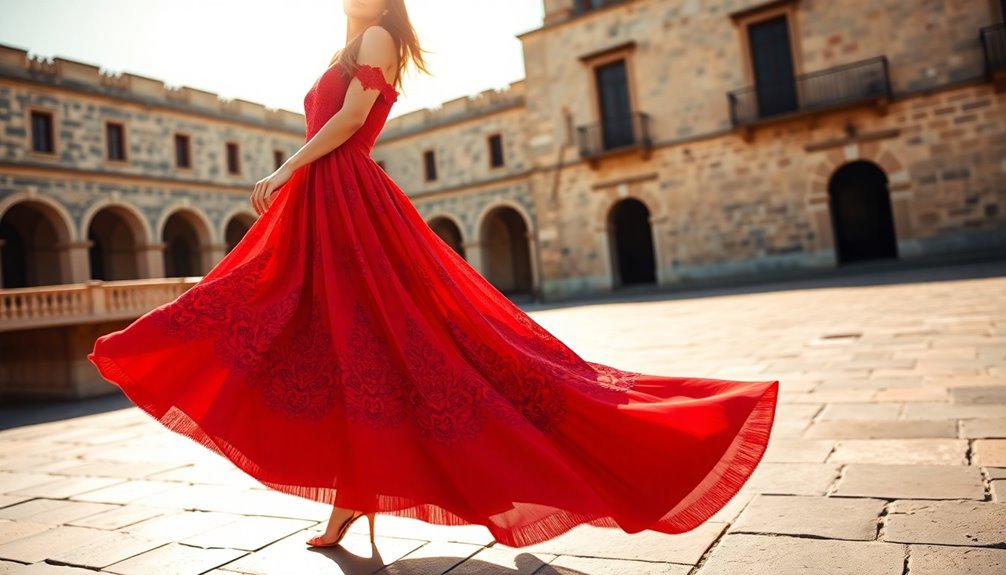
When you explore modern interpretations of Spanish dresses, you'll notice a strong emphasis on sustainable fashion practices adopted by renowned fashion houses.
These designers aren't just innovating styles; they're also pushing for eco-friendly materials and methods that resonate with today's conscious consumers.
You’ll find that fashion icons and innovators are leading the way, marrying tradition with modern values to create stunning, timeless pieces. This evolution in fashion aligns perfectly with a growing trend towards eco-friendly materials that are not only stylish but also environmentally responsible. Some of the best traditional Japanese fashion brands are embracing this shift by incorporating sustainable practices and materials into their designs. By combining centuries-old techniques with modern innovations, these brands are producing beautiful, eco-friendly clothing that resonates with today’s conscientious consumer. With this marriage of tradition, modern values, and eco-friendly materials, fashion is not only becoming more sustainable but also more meaningful and impactful.
Sustainable Fashion Practices
Sustainable fashion practices in Spain are gaining momentum, with designers increasingly prioritizing eco-friendly materials like organic cotton, Tencel, and recycled fabrics. This shift not only helps reduce environmental impact but also promotes responsible consumption among consumers. By embracing these sustainable fashion practices, you're contributing to a healthier planet.
Many Spanish designers are adopting slow fashion principles, focusing on quality craftsmanship and timeless designs that encourage you to buy less and cherish your garments longer. This approach fosters a deeper connection to your wardrobe, making each piece more meaningful.
Additionally, the incorporation of local artisanal techniques, such as hand-weaving and traditional embroidery, supports local economies while preserving cultural heritage.
Transparency in supply chains is becoming commonplace, allowing you to trace the origins of your clothing and make informed choices. The rise of upcycling and vintage fashion in Spain reflects a growing awareness of sustainability, with brands encouraging the reuse of materials and fostering a circular economy.
Renowned Spanish Fashion Houses
The landscape of Spanish fashion is enriched by renowned houses that seamlessly blend traditional craftsmanship with modern innovation. Brands like Balenciaga and Loewe lead the way, celebrated for their innovative designs that significantly influence global fashion trends.
Zara, part of the Inditex group, revolutionized fast fashion with a model that prioritizes rapid production and distribution of runway-inspired styles, making high fashion accessible to everyone.
Manolo Blahnik stands out among renowned Spanish fashion houses with his exquisite handcrafted footwear, merging artistry and comfort. His shoes have become staples in high fashion and are favored by celebrities worldwide.
Similarly, the couture house of Pedro del Hierro reflects Spanish heritage through elegant, timeless pieces that cater to contemporary tastes, emphasizing high-quality fabrics and craftsmanship.
Don't overlook Desigual, established in 1968, known for its vibrant colors and unique patchwork designs. This label represents a playful and artistic approach to modern clothing, resonating with a diverse audience.
These renowned Spanish fashion houses not only embody elegance and creativity but also showcase the rich cultural tapestry that defines Spain's fashion identity.
Fashion Icons and Innovators
Spain's fashion scene has truly embraced the modern interpretation of its rich heritage, blending traditional elements with contemporary flair. Fashion icons like Penélope Cruz and Rosalía have played pivotal roles in this evolution, showcasing classic Spanish garments with fresh, modern twists that captivate global audiences. Their influence has elevated traditional attire, making it relevant and desirable in today's fashion landscape.
Designers like Cristóbal Balenciaga, known for his innovative silhouettes, laid the groundwork for a new generation of creators. Brands like Loewe and Mango seamlessly combine traditional craftsmanship with contemporary design, reflecting Spain's cultural identity while appealing to a wide audience.
You'll find vibrant colors, intricate embroidery, and playful ruffles that echo flamenco roots yet resonate with modern tastes.
Moreover, the rise of sustainable fashion is reshaping the industry. Brands such as Ecoalf lead the charge, promoting eco-friendly practices without sacrificing style. This commitment to sustainability ensures that the timeless elegance of Spanish dresses remains relevant, allowing you to embrace fashion that respects both heritage and the planet.
In this dynamic landscape, Spain's fashion icons and innovators continue to inspire and redefine elegance for the modern world.
Styling Tips
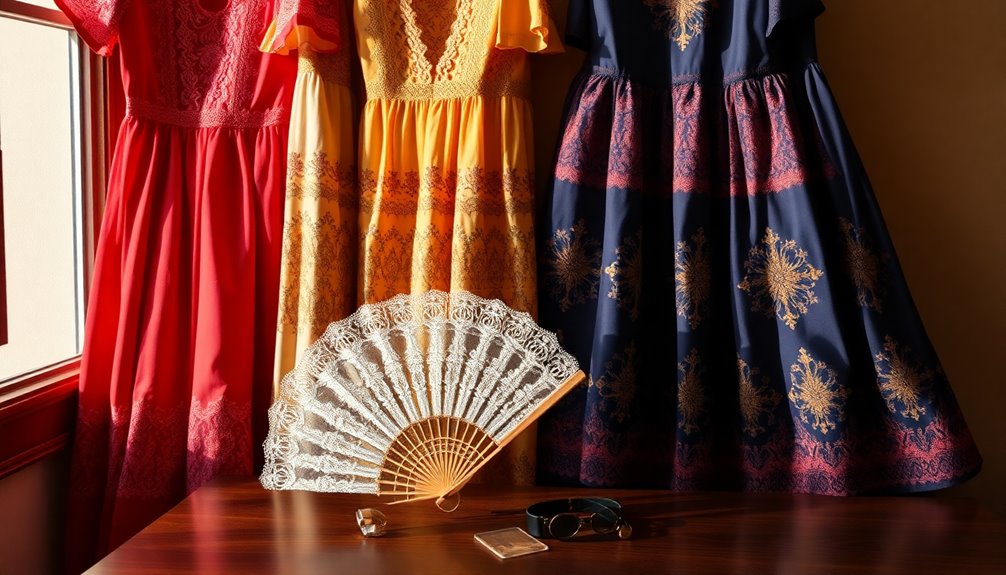
When styling your Spanish dress, think about incorporating classic accessories that enhance your look.
Flamenco-inspired ensembles can really shine with the right layering of textures and patterns.
Classic Spanish Accessories Collection
Timeless elegance shines through in classic Spanish accessories, offering a perfect way to elevate your wardrobe. Incorporating traditional elements like mantillas—lace or silk veils—adds historical charm to modern outfits, especially for formal occasions.
Large, ornate earrings or chandelier designs are also essential; these statement pieces can effortlessly enhance both casual and formal looks.
Don't overlook the flamenco-inspired fan, crafted from silk or lace. This accessory not only serves as a stylish addition but also provides functionality during warmer weather.
When it comes to fabrics, embrace vibrant colors and floral patterns that reflect the lively spirit of Spanish culture, particularly in scarves and handbags.
To complete your ensemble, consider wearing a classic Spanish wide-brimmed hat, like a sombrero or boater style. This chic accessory not only protects you from the sun but also adds a sophisticated vibe to your outfit.
Flamenco-Inspired Ensemble Suggestions
Embrace the vibrant allure of flamenco-inspired ensembles to create a striking look that captures the essence of Spanish culture. Start with a flamenco dress that features a fitted bodice and a flared skirt, perfect for accentuating your movements. Choose vibrant colors or classic polka dots and floral patterns to honor the traditional Andalusian style while standing out in any setting.
When accessorizing, consider adding bold earrings and a flower hairpiece to enhance the drama of your outfit. A shawl can be a fantastic addition, providing elegance and a touch of authenticity that completes the flamenco look. Opt for fabrics like silk, chiffon, or cotton; these materials not only offer comfort but also help create that captivating flow as you move.
For a polished finish, remember to style your hair in soft waves or a sleek updo, allowing your accessories to shine. Incorporating natural elements into your overall look can further enhance the serene and elegant vibe of your flamenco-inspired ensemble.
With these flamenco-inspired ensemble suggestions, you'll embody the passionate spirit of Spanish culture, making a memorable impression wherever you go. Whether it's for a dance performance or a festive gathering, you're sure to turn heads and celebrate the beauty of flamenco fashion.
Layering Textures and Patterns
Layering textures and patterns can elevate your Spanish-inspired wardrobe, adding depth and sophistication to your look. Embrace the art of layering by combining lightweight fabrics like silk or chiffon with heavier materials such as wool or leather. This balance creates a silhouette that embodies Spanish elegance.
Don't shy away from bold patterns; incorporate florals or geometric designs to add visual interest. Make sure at least one piece in your ensemble features a striking print for a cohesive appearance.
Experiment with textures by pairing a smooth satin dress with a chunky knit cardigan or a structured blazer. This mix creates depth and dimension in your outfit.
Accessories play a crucial role, too—consider adding embroidered shawls or patterned scarves to enhance your layers. These pieces not only provide versatility but also infuse a touch of traditional Spanish flair.
Finally, opt for a color palette that includes warm, earthy tones like terracotta and olive green. This choice evokes the rich landscapes of Iberia while allowing you to mix and match various textures and patterns effortlessly.
With these tips, you'll master the art of layering textures and patterns in your wardrobe.
Shopping Guide
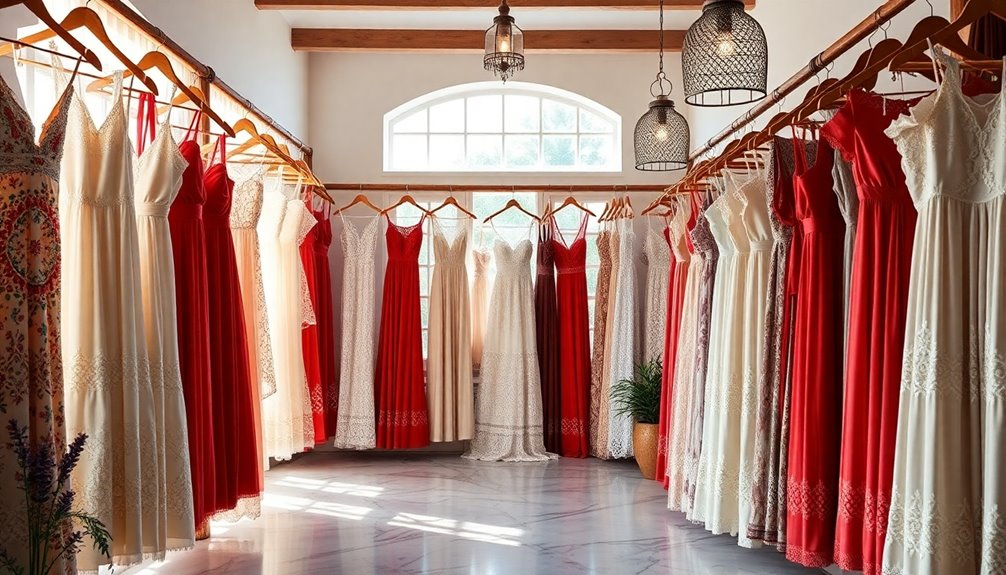
When it comes to finding the perfect Spanish dress, you'll discover a wealth of options that beautifully blend tradition and modern style. Spain is renowned for its vibrant fashion scene, where traditional garments like flamenco dresses showcase ruffles, lace, and bold colors.
To dive into this fashion paradise, head to Madrid's Gran Via or Barcelona's Passeig de Gràcia. Here, you'll find a mix of high-end boutiques and local designers, each offering unique interpretations of Spanish elegance.
Don't miss seasonal fashion weeks in cities like Barcelona, where you can catch the latest trends and see how international influences shape Spanish designs. For a more personalized experience, explore local markets and artisan shops. You'll find unique, handcrafted dresses that capture the essence of Spain while supporting local craftsmanship.
Keep an eye out for dresses made from exquisite Spanish fabrics, especially silk and lace, often crafted using traditional techniques passed down through generations.
Whether you're looking for something classic or contemporary, your shopping adventure in Spain promises to be a delightful journey into timeless elegance.
Handcrafted Embellishments for Dresses
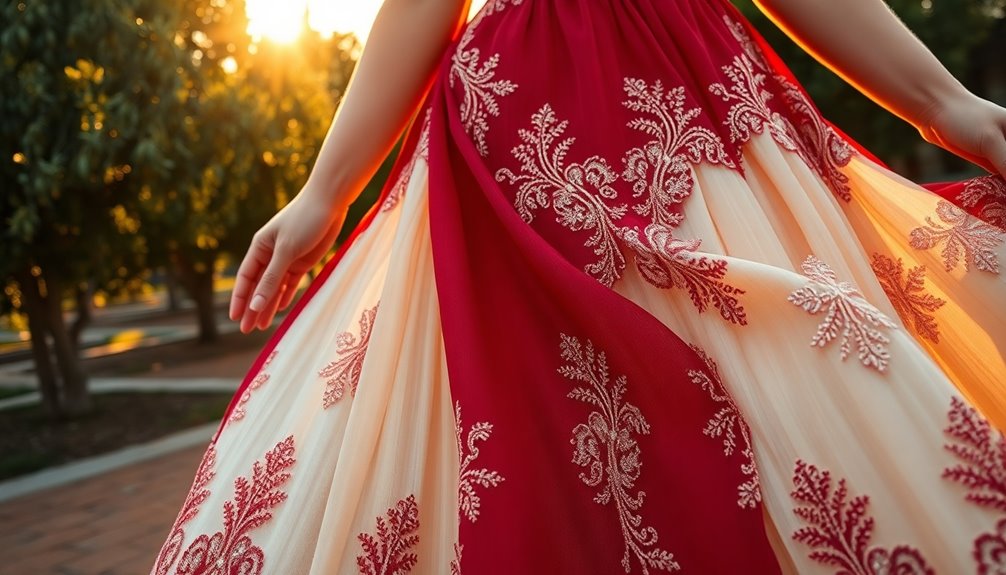
When you think about Spanish dresses, the beauty of handcrafted embellishments really stands out.
Techniques like handmade floral appliqué and personalized embroidery options not only enhance the dress but also tell a unique story.
You'll find that these details reflect the rich cultural heritage and artistry that Spain is known for.
Handmade Floral Appliqué Techniques
Many artisans embrace handmade floral appliqué techniques to transform simple dresses into stunning works of art. This meticulous process involves sewing or gluing fabric cutouts onto a base garment, creating intricate designs that enhance your dress's aesthetic appeal.
Often seen in traditional Spanish dresses, these techniques allow for customization and personalization, reflecting the rich cultural heritage of the Iberian Peninsula.
Using natural fabrics like cotton, silk, and linen adds both durability and elegance, making these embellished garments perfect for various occasions. When you wear a dress adorned with handmade floral appliqué techniques, you're not just donning a piece of clothing; you're embracing a tradition steeped in artistry.
Skilled artisans frequently incorporate additional methods like embroidery and beading alongside appliqué to add texture and dimension, elevating the overall design.
You'll find that floral appliqué varies by region, showcasing distinct patterns and color palettes that represent local flora and traditions. By choosing a dress with these exquisite details, you celebrate the craftsmanship and uniqueness that Spanish fashion has to offer, ensuring you stand out with timeless elegance. Additionally, many of these artisanal techniques can be likened to herbal alternatives for botox-like effects, as they both focus on enhancing beauty through natural and traditional methods.
Personalized Embroidery Options
Building on the artistry of handmade floral appliqué, personalized embroidery options take customization a step further. In Spain, you'll find that these options often include intricate designs reflecting regional motifs, showcasing local craftsmanship and cultural heritage.
When you choose personalized embroidery, you can select thread colors and patterns that align perfectly with your style, making your dress truly one-of-a-kind.
Handcrafted embellishments, such as hand-stitched lace or detailed floral embroidery, add exquisite texture and elegance to your garment. These personalized embroidery options not only enhance your dress's visual appeal but also create a meaningful way to commemorate special occasions.
Each stitch tells a story, turning your dress into a cherished keepsake. Additionally, embracing unique decor styles can inspire creativity in your fashion choices, further enhancing your overall aesthetic.
Keep in mind that custom embroidery services may take several weeks to complete, but this ensures meticulous attention to detail and high-quality finishes. This patience pays off, as you'll end up with a dress that embodies your unique taste and celebrates your personal journey.
Embrace the beauty of personalized embroidery options and elevate your wardrobe with a touch of timeless elegance from the heart of Iberia.
Cultural Impact
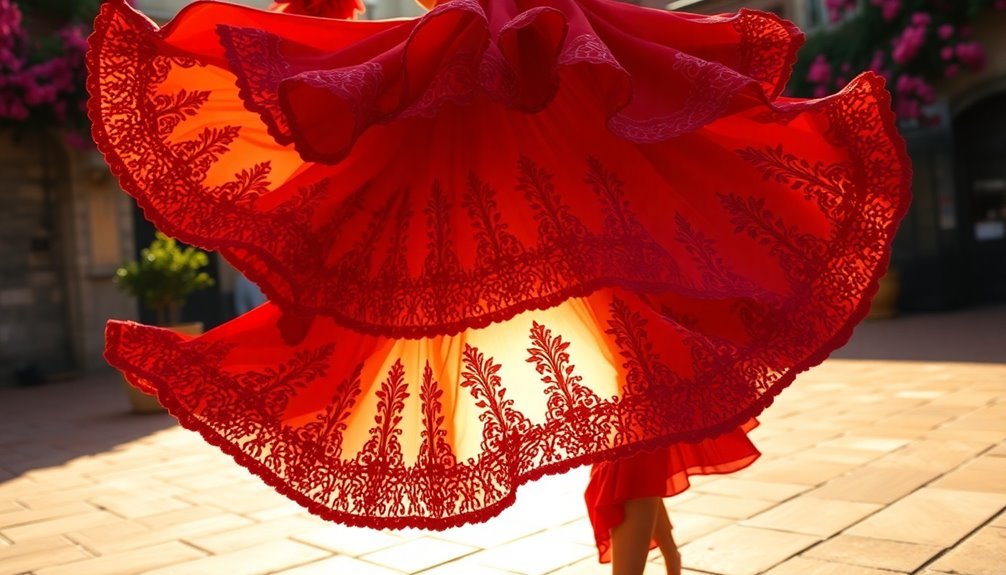
When you think about Spanish dresses, it's hard not to connect them to the vibrant world of Spanish cinema and iconic fashion figures.
These dresses not only enhance the storytelling in films but also reflect a unique blend of tradition and modern feminism.
You'll see how these cultural elements influence and inspire fashion trends both in Spain and beyond.
Spanish Films and Fashion Icons
Spanish cinema has long shaped global fashion trends, effortlessly blending vibrant styles with traditional attire. Films like "Volver" and "The Skin I Live In" showcase the cultural richness of Spain, spotlighting the unique aesthetics that define its identity.
You can't help but notice how iconic Spanish actresses, such as Penélope Cruz and María Valverde, embody fashion icons, influencing trends through their captivating performances and red carpet appearances.
The resurgence of traditional garments, like the "traje de flamenca," highlights the enduring appeal of Spanish cultural aesthetics. The flamenco-inspired dresses, characterized by ruffles, bold colors, and intricate embroideries, have become synonymous with the nation's identity, thanks in part to their representation in film.
Renowned designers like Balenciaga and Pedro del Hierro often feature their creations in cinematic storytelling, merging haute couture with the art of filmmaking.
This fusion of Spanish folklore and contemporary fashion not only enriches the cinematic experience but also ignites a renewed interest in traditional attire, inspiring audiences worldwide.
As you explore the world of Spanish films, you'll find that these actresses and their styles play a pivotal role in shaping the fashion landscape.
Fashion and Feminism in Spain
The vibrant interplay of fashion and feminism in Spain reflects a society that's continually evolving while honoring its rich heritage. Over centuries, women's attire has been shaped by diverse influences, from Roman and Moorish traditions to modern innovations.
The mantilla, a traditional lace veil, symbolizes both elegance and femininity, often gracing religious ceremonies and celebrations.
In recent years, the feminist movement has significantly impacted Spanish fashion, pushing for more inclusive representations of women's bodies and styles. This shift has led to a celebration of the iconic flamenco dress, with its vibrant colors and ruffles becoming a powerful symbol of empowerment. It honors women's strength and cultural identity, merging traditional elements with contemporary flair.
Influential Spanish designers like Cristóbal Balenciaga and Manuel Pertegaz have elevated women's fashion on a global scale, blending classic styles with modern aesthetics.
As feminism continues to reshape the fashion landscape, you can see how it encourages diversity and authenticity in women's dress. This evolving narrative not only honors Spain's rich history but also paves the way for future generations to embrace their individuality while celebrating the power of femininity.
Frequently Asked Questions
What Fabrics Are Commonly Used in Traditional Spain Dresses?
When you explore traditional Spanish dresses, you'll find a variety of fabrics that reflect the country's rich culture.
Common materials include silk, which adds a luxurious touch, and cotton, known for its comfort.
Linen is often used for its breathability, especially in warmer climates.
You might also notice vibrant brocade and lace, which enhance the intricate designs.
These fabrics not only showcase craftsmanship but also bring a sense of history to each garment.
Are There Specific Occasions to Wear Spain Dresses?
Yes, there are specific occasions when you can wear traditional Spanish dresses.
You'll often see them at festivals, like Feria de Abril or Semana Santa, where vibrant colors and intricate designs shine.
They're also perfect for weddings, flamenco performances, and cultural celebrations.
If you're attending a themed event or want to embrace Spanish culture, slipping into one of these dresses can make a memorable statement and connect you to rich traditions.
How Do I Care for Spain Dresses?
To care for your dresses, start by always checking the care label for specific instructions.
Hand wash or use a gentle cycle with cold water to maintain fabric integrity. Avoid bleach and harsh detergents; instead, use mild soap.
Hang to dry or lay flat, keeping them away from direct sunlight to prevent fading.
Iron on a low setting if needed, and store them in a cool, dry place to keep them looking their best.
Can Spain Dresses Be Customized or Tailored?
Absolutely, you can customize or tailor Spain dresses to fit your unique style and body shape.
Whether you want to adjust the length, change the neckline, or add embellishments, a skilled tailor can help you achieve the perfect look.
Just make sure to communicate your preferences clearly and choose high-quality fabrics to ensure the best results.
Your personalized dress will stand out and make you feel confident at any occasion.
Where Can I Learn More About Spanish Fashion History?
If you want to dive into Spanish fashion history, you've got plenty of options.
Check out online resources like fashion blogs and documentaries that focus on cultural heritage. Visiting local museums or fashion exhibitions can also give you a hands-on experience.
Books by fashion historians provide in-depth insights, too. Don't forget to explore social media platforms, where influencers often share valuable tidbits about Spain's rich fashion legacy.
Enjoy your journey!

